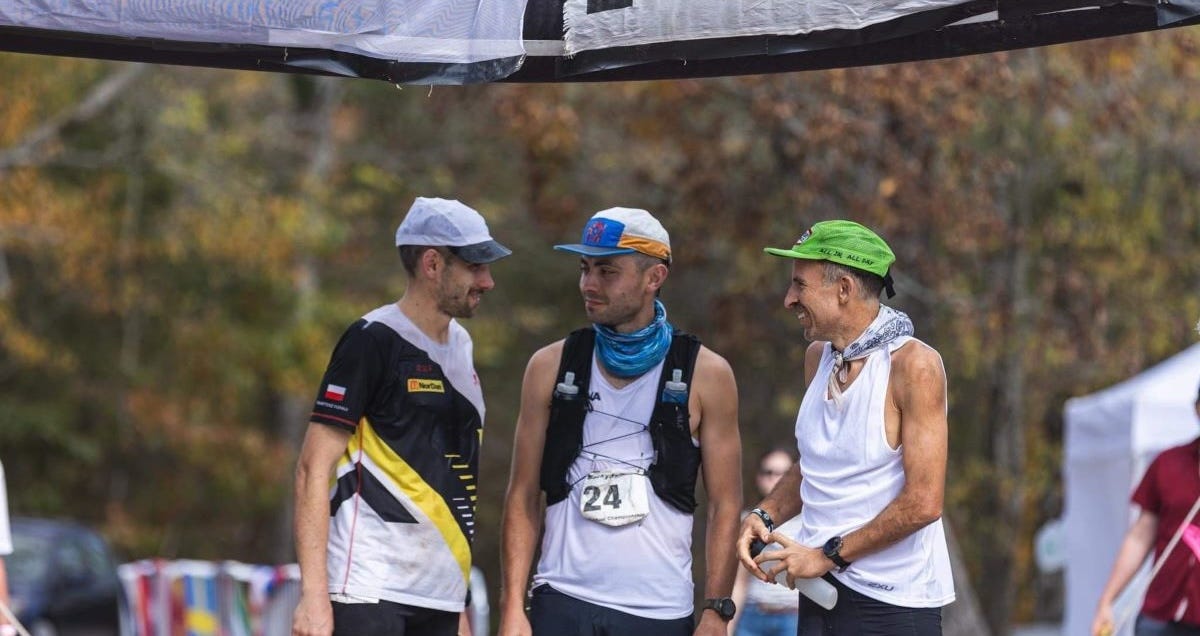Why Do Ultra Endurance Athletes Get Better With Age?
Ultra-endurance athletes peak in their late 30s, yet physiological gains plateau much earlier. In this article, we review the science in an effort to understand this anomaly.
At 38, Courtney Dauwalter became the first person ever to win the Western States 100, Hardrock 100 (with a women’s course record), and UTMB in the same year, being the first human to ever complete the ultrarunning triple crown. A year later, at 39, she broke her own Hardrock 100 course record and set the women’s record at the Mt. Fuji 100.
At 34, Kilian Jornet smashed course records at Hardrock 100 and UTMB. Two years later, at 36, he set the record at Sierre-Zinal, a shorter (31km) but competitive race. Following that, he embarked on a diametrically opposite adventure where he linked all 82 of the Alps’ 4,000-meter peaks in a single push.
At 40, Jasmin Paris became the first woman to finish the Barkley Marathons, making her just one of 20 people who’ve ever completed the race.
And at 41, Aleksandr Sorokin broke his own 100km world record, cementing his status as the fastest person ever over that distance.
What ties these athletes and performances together is that they were achieved during what many would consider as the twilight of their careers. Conventional wisdom says that an athlete’s prime years are in their late 20s or early 30s, yet these runners managed to outperform their younger selves and (and in some cases, every other human ever). Therefore, the question is inevitable: how do they keep getting better with age?

Understanding Ultra Endurance Athletes’ Physiology
At the end of the previous section with a very speculative claim - that an athlete’s prime years are in their late 20s or early 30s. Let’s start by looking into this claim.
Allen and Hopkins’ scientific review found that in explosive power or sprint sports, peak age decreases as event duration increases. For example, athletes in throwing events (like javelin or discus) peak at around 27, while those in short-duration events (like swimming or track races up to 5 minutes) peak at around 20.
However, for endurance events, the trend flips. The longer the event, the older the peak age. Ultra-distance cycling events lasting over a day see peak performance at around 39, very close to the athletes and performances mentioned in the introduction. The same research notes that most physical capabilities, like VO2max and aerobic efficiency, peak at around 30.
This claim is also backed up by a study by Martin and Farar, who found that peak power typically hits its highest point in an athlete’s 20s and stays relatively stable through their 30s. This suggests that as ultra-endurance athletes improve beyond their peak physical capabilities, they’re enhancing other factors, both physiological and non-physiological. Let’s try to nail down what the physiological improvement can be.
To understand why endurance athletes improve with age, we need to look beyond raw metrics like power, VO2max, and lactate threshold. This isn’t necessarily surprising, since we already knew that ultra-endurance athletes rarely rely on their maximal physical capabilities. Thankfully, Manuel Mateo-March et al.’s research points us toward a potential answer.
This research group studied over 100 professional cyclists riding for World Tour and Pro Tour teams, testing their maximal power both when fresh and fatigued. While all riders, irrelevant of their level, had similar maximal power when fresh, Pro Tour riders’ power dropped significantly more under fatigue compared to World Tour riders. This suggests that the key difference between an elite rider and a lower category rider isn’t necessarily raw power, but the ability to maintain power when fatigued. A Dutch-based research group did a similar study and came to the same conclusion. Unfortunately, similar studies in running are scarce, likely because running lacks an equivalent to cycling’s power metrics. Nonetheless, this gives us an avenue for investigation.
So let’s sum this the research:
Most physical capabilities peak in the late 20s or early 30s and yet,
Endurance athletes peak in their late 30s.
The difference between elite cyclists and sub-elite cyclists is how well athletes can perform when fatigued, rather than the maximal physiological output.
With all this in mind, the final step is to dig deeper into performance under fatigue and explore whether it’s linked to an athlete’s age. Luckily, the scientific community already has a name for this phenomenon: durability.

What The Heck Is Durability?
The research group led by Ed Maunder defines durability as how long it takes for your body to start wearing down during prolonged exercise and how much your performance drops when it does. In simple terms, it’s your ability to keep performing well even as fatigue sets in.
Why Does Durability Matter?
The researchers point out that athletes are often profiled using metrics like VO2max, aerobic capacity, or lactate threshold, but these are typically measured when the athlete is fresh. There’s also an assumption that these values stay constant throughout prolonged activity, but that’s not the case.
The research provides examples such as marathon runners and cyclists experiencing “heart rate decoupling,” where their heart rate and pace/power drift apart over time. Additionally, they present a scenario where a mountain bike athlete spends less time above critical power during repeated efforts of similar effort. These examples suggest that durability is a key performance differentiator for ultra-endurance athletes and should be a very important consideration when considering ultra endurance performance.
How Can You Measure Durability?
Unfortunately, unlike metrics like VO2max or FTP, there’s no standard way to measure durability. The decrease in performance isn’t clearly tied to training load or other lab-measured metrics, either.
If you want to try measuring your durability, your best bet is a field test inspired by the examples draw from the studies mentioned earlier. Here are two examples:
Steady-State Test: Perform a steady-state run or ride for 4+ hours and analyze the decoupling between heart rate and pace/power.
Interval Comparison Test: Do a few high-intensity intervals at the start of your workout, follow it with steady-state exercise, and then repeat the intervals at the end. Compare the pace/power of the intervals (assuming similar heart rate) to gauge your durability.
While these tests are a reasonable starting point, they lack standardization. Factors like air temperature, nutrition, hydration, or pre-workout fatigue can muddy the results, making it hard to tell if improvements are due to durability or something else.
The only software I know of that attempts to measure durability is Garmin’s Endurance Score. However, as someone who’s skeptical of Garmin’s metrics due to some past bad experiences, I’m not sure I’d fully trust it.
How Can You Train Durability?
Research on training durability is still limited, but thankfully we have some clues.
A Finnish research group found that both low- and high-intensity endurance training can improve durability. However, the study was done on sedentary and recreationally active people, not well-trained athletes, so it’s unclear whether the gains were from the training itself or just “newbie gains.”
Gabriele Gallo tested trained cyclists’ durability after two different training interventions:
High-intensity intervals done after a long, low-intensity session.
High-intensity intervals done on a separate day from low-intensity sessions.
The results showed that the group doing high-intensity intervals after steady-state sessions improved their durability more than the other group.
This study shows that even though we can’t precisely measure durability, we can still train it by incorporating high-intensity efforts after longer, steady-state sessions.
If I had to zoom out and extrapolate from these studies, I’d guess that the best way to build durability is to spend as much time training while fatigued. However, this can be a very destructive process, which is why conventional wisdom says we should recover adequately from sessions and train in a fresh state. However, in long endurance events like races, we’re forced to push our limits and keep moving despite fatigue. Since these events are so grueling, most athletes only experience them a handful of times a year. Consequently, the biggest contributor towards improving your durability is likely your years of training. Over time, you would have inevitably done a number of long, hard efforts, effectively increasing your durability through repeated exposure to fatigue.

So, Why Do Endurance Athletes Get Better With Age?
The truth is, we don’t fully know…yet. What we do know is that while most athletes hit their physical peak by their early 30s, ultra-endurance athletes continue improving for years beyond that. Sure, some of this improvement might come from mental toughness, better nutrition, or race strategy, but I believe a big part of it comes down to durability.
Durability, the ability to perform well under fatigue, is built by training while fatigued. Athletes are most fatigued during ultra-endurance events like races. Since race experience accumulates over years of competing, athletes in their late 30s often have the right mix of physical capabilities and high durability, allowing them to produce outstanding performances later on in their career compared to athletes in other disciplines.
Author’s note: Between the time of writing and publishing this article, coach Jason Koop released a podcast where he talked about durability. He takes a different angle to the topic, including about how strength training may benefit durability. If you would like to learn more, I would recommend listenong to this podcast.





I’ve always thought there’s some survivorship bias at play here, too. In ultra-endurance sports, experience often outweighs other factors, so athletes can continue improving into their late 30s and beyond as they accumulate more years of hard training.
*Unless* they leave the sport because of the toll that same training takes, in which case they wouldn’t be included in studies on peak age.
Fascinating article, thank you!